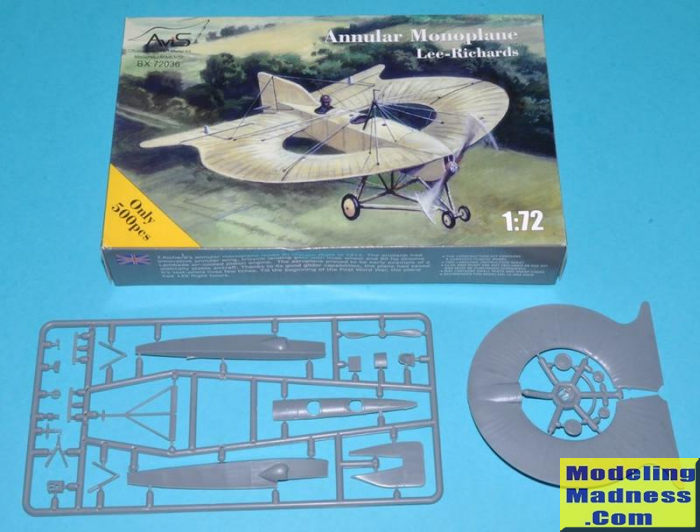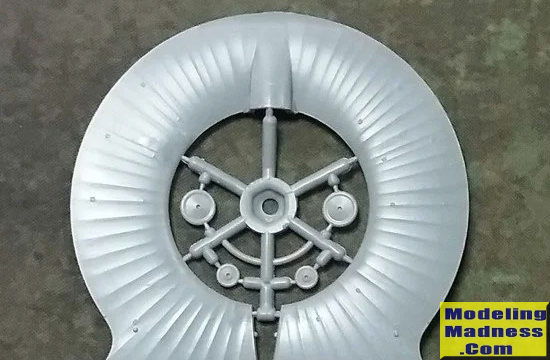
| KIT #: | BX 72036 |
| PRICE: | AUD$39.00 |
| DECALS: | none (Yay!!) |
| REVIEWER: | George Oh |
| NOTES: | One of 500 kits |

| HISTORY |
Aircraft with an flat ring-shaped (aka, annular) wing was patented by Williband Franz Zelger and Isaac Henry Storey. One was built by John George Aulsebrook Kitchen, but it didn't fly. The patents and the kitchen aircraft were bought by Cedric Lee and G Tilgdman Richards who refined the design and their first 1911 prototype was unsatisfactory, and it was destroyed when its hanger collapsed in a strong wind. They built more, one a ring with a standard second/top wing, a bi-ring model, and a single-ring one - each with differences to the control surfaces. All were twin-seaters.
Right here (https://modelingmadness.com/review/w1/gb/peachanbi.htm) in MM, you can read about how Chris Peachment built a model of the annular-wing biplane, and I was insanely jealous - of his modelling abilities and the fact that he had a model of one of the weirdest aircraft that I'd never even head-of (though I had supposedly seen it in the movie "Those Magnificent Men in their Flying Machines"). So, naturally, when I saw this model of the Lee-Richard's No. 3 aircraft in my LHS (and in my preferred scale, too), I rushed-in (and I might have trampled a baby) to get it.
| THE KIT |
The instructions are on an A4-sheet that has a very-brief history, a parts map, a painting-guide, and 5 assembly panels. The flimsy end-opening box also holds two (1.5?) sprues inside a resealable plastic bag. The 26 parts show some flash and mould-slippage. Inside, there is a Hobbit-sized seat and 3 more cockpit parts, a 2-part fuel tank(?) which will be unseen, but nothing for the forward cockpit. The wing is a one-piece affair with (IMHO) quite subtle rib detail and moulded-on control surfaces. References differences about some details. The aircraft had a rotary engine, so the fuselage had side bulges to accommodate it. The bulges, and the underside of the fuselage may, or may not, have had openings to help the engine cool. This kit lacks an engine and the underside opening, but it has the openings (moulded sealed) on the front of the bulges.
 There
is no rigging diagram, but the box-art will do for the upper surfaces. It
only hints at a little rigging for the underside, while Internet pictures
show a lot more. Unusually the rigging anchor points are raised dots that I
will be replacing with dimples or perhaps even holes drilled through the
wing, to accommodate the underside rigging as well. It seems unusual to me,
but the upper king-post for anchoring the rigging, is NOT centred on the
wing's centre-point. I am wondering whether I should shift it to a point
just behind the forward seat (where it would be a MAJOR inconvenience to the
passenger). The underside king-post is the same and is the centre-support
for the main undercarriage.
There
is no rigging diagram, but the box-art will do for the upper surfaces. It
only hints at a little rigging for the underside, while Internet pictures
show a lot more. Unusually the rigging anchor points are raised dots that I
will be replacing with dimples or perhaps even holes drilled through the
wing, to accommodate the underside rigging as well. It seems unusual to me,
but the upper king-post for anchoring the rigging, is NOT centred on the
wing's centre-point. I am wondering whether I should shift it to a point
just behind the forward seat (where it would be a MAJOR inconvenience to the
passenger). The underside king-post is the same and is the centre-support
for the main undercarriage.
This aircraft has tricycle undercarriage fixed to an underside frame, with the main wheels well-forward of the apparent CG (Centre of Gravity). The instructions don't mention anything about the need for a nose-weight, but there is plenty of room for it. For ease, I might complete the underside rigging BEFORE attaching the undercarriage frame, and the wheels, to the model.
| CONCLUSIONS |
Full marks to AviS for their courage in producing two kits (they also do a more-detailed kit in 48-scale (No. BX 48001) of this unusual aircraft.
To be fair to the pioneers of aircraft design, they were trying to discover what an aircraft should look-like. So there was a dearth of ideas, but no real communication between different designers (see the movie "Those Magnificent Men in their Flying Machines". It is one of my favourite movies).
March 2022
Copyright ModelingMadness.com. All rights reserved. No reproduction in part or in whole without express permission.
If you would like your product reviewed fairly and quickly, please contact the editor or see other details in the Note to Contributors.